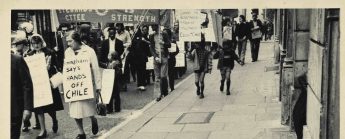Shahmima Akhtar is a PhD student researching Commercial Exhibitions of the Irish in World Fairs’ in the Nineteenth and Twentieth Centuries in Britain and the US. This blog looks at an iconic Irish Village: “Ballymaclinton”, repeatedly exhibited at World Fairs’.
“Ballymaclinton” was an Irish village, repeatedly exhibited for seventeen years from 1907 to 1924 in various national and international exhibitions. The display of Ballymaclinton fits within a wider context of the exhibition of peoples and places that reached its height in the twentieth century. Exhibitions were alternatively used for commercial purposes, anthropological interest or at its apex as powerful displays of a country’s industrial and economic progress.
Arguably as magnificent displays of a country’s achievement, those that were exhibited became crucial proponents of particular, idiosyncratic narratives.
The British exhibition of the Irish often became a popular means of reinforcing colonial hierarchies, asserting the metropolitan’s core of control and justifying its imperial domination. However, the Irish exhibition of the Irish, complicates this neat understanding of power relations personified on the world stage.
Brown and Son Soap Company of County Tyrone, conceived of Ballymaclinton as a sort of Irish utopia. It epitomised everything Ireland could be. Replete with displays of Irish progress, Irish industrial achievements, Irish art and architecture, Ballymaclinton offered a striking alternative to racist and derogatory British arguments as to why Ireland had to be ‘colonised for its own sake’.
Within this constructed fantasy of an idealised Ireland, exhibited Irish women (colleens) played a crucial but often undervalued role. They ‘sold’ the idea of a prosperous, innovative, ‘new’ Ireland in the twentieth century. The colleens numbered from 200 to 250 at various exhibitions. They called home the exhibition grounds during its six-month seasons, living and working; offering a performative display of traditional ‘Irishness’.
Brown and Son Company used the colleens to demonstrate the utility of their soap. Its crowning achievement being to ‘whiten skin’. The Irish, already white in appearance, further had to scrub themselves ‘whiter’.
This peculiar project speaks to a whole host of happenings in the twentieth century that can be traced as far back as the 1600s. The Irish were ostensibly attempting to challenge racist British imperial stereotypes of the Irish as dirty, diseased, and lazy. These negative tropes manifested in a conceptual darkening of the Irish. They had to be washed clean. The evolution of dark skin to white becoming the raison d’etre of imperial British soap companies. Indigenous groups could join the march of civilisation by washing themselves white.
Clearly then, what on the face of it, seems like an ordinary Irish village, ordained with a blarney stone, a clock tower, a church, a herd of pigs and cows, reveals an immense amount about twentieth century Britain and Ireland and the discriminatory narratives they were operating within.


Reblogged this on oshriradhekrishnabole.